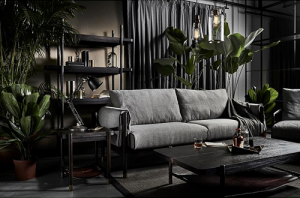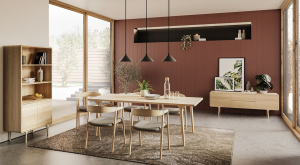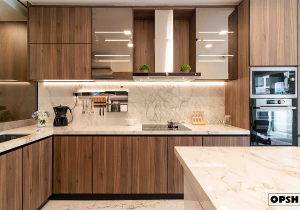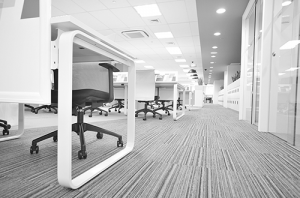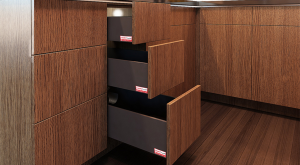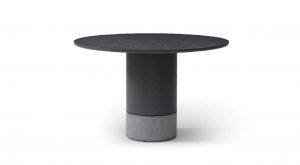Star Living: The Next Frontier
From its humble beginnings as a two-man show to a medium enterprise that integrates furniture design, manufacturing, retail and export all under one roof, local brand Star Living has grown from strength to strength by capitalising on technology to innovate on all fronts of its business – not least on the digital platform. In this article, Star Living Group Corporate & Retail Director Xu Xue Ting shares some insightful tips on e-commerce and digital marketing strategies that have worked for the brand, and how they hold fast to their brand values even as they go digital.
Could you tell us a little about how Star Living began?
Back in 1981, it was just a two-man show that my father and his brother had set up called Ngoh Hock Furniture Maker. Ngoh Hock means ‘five fortunes’ in Hokkien, as my father named the company after his family of five brothers. My father and uncle would go out and buy panel and wood, and they would use their own bare hands to make furniture. It was very small-scale. They started by supplying to small HDB furniture shops, then the business slowly grew to become a sizable wholesale business.
Eventually we branched into retail and production, and somewhere down the road we rebranded it to what it is today. And now, after 40 years, we are an integrated furniture designer, manufacturer, retailer as well as exporter.
Star Living has an extensive network of physical stores as well as a rather strong web presence. What was the journey like in setting up your e-commerce platform?
We started our e-commerce store in 2013, because we recognised that having an online presence was very important even back then. Our first site in 2013 had been built from scratch, but it was not user-friendly and the data was not synced to our inventory system. So whenever we had transactions coming through whether online or in our physical stores, we needed to manually update the stock level on the website. Considering that we had several hundred products, it was a very tiresome process.
In 2016, we revamped the whole website and moved onto a Shopify platform. We built an API (application programming interface) that could sync all the sales and all the data with our SAP (Systems Applications and Products in Data Processing) system. That became so much more seamless, and we no longer have to manually update the stock information.
Now, five years on, we’re planning our next revamp to improve the user experience on our website. There are many brands and companies out there in the market that are running very good e-stores, so we would like to learn from them. We hope to improve our video and photo content, as well as the customer journey and site experience.
What role does your webstore play in facilitating sales and the customer relationship?
We see our online store as a complementary platform to the physical store. We find that a lot of customers browse online, and then head out to our stores when they find something that they like. Or vice versa, they may go down to a store, then they may shop around at other shops. And when they are ready to make the decision they can opt to buy online out of convenience.
What is the proportion of sales that are closed online compared to in-store?
At less than 3%, our online sales are still a very small percentage of our total sales. But based on the data that we get from Google’s tracking software, we know that many of our customers actually visit our store after seeing us online. We work with a digital agency to use a software that tracks customer behaviour if their location services are switched on. While the numbers may not be 100% accurate, it gives us a good sense of whether our digital efforts are working.

What kind of services does the agency provide? Is it things like SEO (Search Engine Optimisation) as well?
Yes – SEO, SEM (Search Engine Marketing), and GDN (Google Display Network). And whenever Google has new tools, our agency would recommend it to us if they find it relevant for our business. We are currently exploring with them on how to use YouTube for our digital assets.
Can you share a little bit about what Star Living has in the pipeline for that?
Since last year, we’ve been focusing on creating more digital content. We have a marketing team that creates our photo and video shoots in-house, and so far we’ve been rolling out one or two videos per month centred on different themes. With all this content that we have on hand, we’ve been doing quite a bit on social media platforms like Facebook and Instagram.
Our agency recommended that since we have so much digital content, we can put it into nice, attractive videos and branch into running some campaigns on YouTube. We are doing some studies on this before we start. Personally, I hate it when ads pop up when I am on YouTube. So I’m a bit sceptical, but still open to trying out what the digital agency has got to offer.
How do you proportion your marketing spend between physical and digital marketing?
We spend roughly 30% on physical ads – that being newspapers and magazines – 50% on digital, and we leave another 20% for events or other kind of advertising like radio and outdoor.
5 to 10 years ago, we used to spend more than 50% on physical ads, especially newspaper ads, but we have cut down a lot of that and channelled the resources to digital marketing instead.
What is your social media strategy like? Is that something that your digital agency advises you on as well?
We handle our social media mostly by ourselves. Apart from creating a lot of digital content, we have a thematic approach that changes monthly. Every month, we come up with a theme which our campaigns, promotions and features will be based on.
For example, this month is on beddings in conjunction with World Sleep Day. Last month it might have been on, you know, Work from Home. We try to have different themes every month to showcase the variety of products that we have.
The marketing team and I work very closely together. And fortunately for me, my team comprises fairly young people between their late 20s to early 30s. So they are quite savvy, and they are always on the lookout for what’s new in the market, what’s new outside in other industries, et cetera. Sometimes we work with other agencies on an ad-hoc basis as well.
What are some new things that you’ve tried recently?
At the end of last year, we worked with an agency to do some Facebook Live events. This was something that’s completely new for us, so we chose to partner an agency to pilot it. These were two hour-long live shows where we showcased some of our products and engaged with our customers through Q&A.
In the first show, I was directly involved in introducing our brand and products and interacting with our audience. For the second show, we had our senior designer feature our new brand Aartical and share some design tips so that our audience could gain some insights from the designer’s point of view.
How did it go?
All in all, the impact of the event was quite encouraging. During the event itself, viewership was pretty low, less than a hundred, and we were a bit disappointed. But surprisingly, when we reviewed the video the next day, the viewership had shot up to more than a thousand, and continued to grow during the period when the video was up. We were also happy to see that the particular product category that we featured also received a lot of inquiries, and the sales actually picked up after the live event.
So even though the live event only lasted for an hour, the fact that the video remained online for a while thereafter meant that there were a lot of opportunities where people could go and visit the video at their convenience.
That sounds quite promising – is this something that you would consider doing again?
Yes, but on an ad-hoc basis rather than regularly, because it’s very tiring. And we really need to engage professional, experienced hosts to do it, because you need someone who can actually engage people and be very enthusiastic throughout the session. After I participated in one session I almost died because it took a lot to keep the energy level up. I think we will leave it to the professionals. [laughs]
But in terms of this approach of educating and engaging instead of hard-selling, it is an approach we intend to continue.
I see that approach play out in the blog section of your online store as well. What prompted the brand to set up something like that, and what does it hope to achieve?
We started the blog because we wanted to create more content for our website, content that was relevant to our customers. So we worked with our agency to come up with current topics for discussion, such as tips that BTO owners might look out for when purchasing furniture for their first home, or what kind of materials customers should consider for their dining table. These are all very relevant topics that our consumers will be interested in.
And also, honestly, blog posts are very important for driving traffic to the website through SEO and backlinks. So it really serves a dual purpose.
What have you found are the most successful digital efforts in engaging your customers?
We found that our video content has been quite successful. We produce videos that showcase our products – their different functions, or what the user experience is like. We use them on our social media as well as in our showrooms, so when customers visit us, they have a consistent message across all platforms.
Whenever we have these videos, the engagement is pretty high and we receive a lot of inquiries. I think consumers nowadays don’t just want to see static visuals – they also appreciate videos that help them better understand how a product works.
And what about challenges? What are some difficulties that you’ve faced in establishing Star Living’s online presence?
Firstly, you really need a lot of time to slowly grow your online community if you’re doing it organically. We don’t believe in buying likes, so this means it really takes time to build up our content, engagement, and fan base.
Also, we find that it is really competitive out there. In the past, we only needed to compete with others on our products. But now in the physical-digital arena, we need to compete on marketing as well. It is no longer enough just to have good products, and marketing can be the deal breaker in the sense.
For many brands out there be it furniture or other product categories, they have very strong marketing although their product may not be very good. But the marketing has the ability to compensate for the product, and these brands can get away with having an inferior product. And now, we have to compete with such brands and companies too.
Were there challenges when it comes to the logistical aspect of managing both an online and physical store?
Fortunately for us, we handle all logistics and fulfilment in-house, so we have a lot of control over that. And we wanted a consistent experience throughout our online store as well as our physical stores. So we run the same promotions and have the same pricing online and in-store. Even the people handling your delivery, the customer service team, everybody is the same so no whether matter you buy online or in our stores, you receive a consistent message and experience.
Does this consistency mean that all the products available in-store are also available online?
No – we do have a few thousand SKUs and only about 70% are online.

How do you decide what goes online and what doesn’t?
It depends – for example, some products such as Hilda – MY Junior Set are modular systems that come in three to four parts. Our current website does not have the capability for our customers to select which modules they need, and it’s difficult for them to visualise how the whole system works. But for our revamp, we are getting a web developer to look into how we can do so in the future.
Apart from technical limitations such as this, we also don’t list the very big-ticket items because we find that the more expensive products are harder to sell online. For every product that we want to list online, we need to put in a lot of time and resources to take photos and manage the product information, so we have to consider what we want to put online carefully.
Are there certain products that actually sell better online?
Oh definitely – smaller items such as dining chairs, benches, and even small chests of drawers or cabinets do well online.
Do you think the scale is what differentiates them – that people are more willing to buy smaller items online?
I think people are more willing to buy smaller items online without needing to see the physical, actual product. But then we also have big sofa sets that cost $2,000 being bought online – these are customers who have seen it at our physical stores.

Star Living prides itself on its customer service as one of the main factors of its success. How does good customer service look like in your physical stores, and how do you translate that into customers’ digital experience of your brand?
We always believe in sincere service, meaning that we treat customers like our friends. We don’t believe in hard-selling or forcing people into making a decision. Because we understand that for big-ticket items such as furniture, people need time to shop around, digest their research – they need time and space to make that decision.
Sincere service also means that we are honest with our customers about our products. For example, if a customer asked us about whether a solid wood table will scratch over time, we will not hide the fact. Instead, we’ll offer to teach the customer how to maintain it.
How do you translate these brand values to your online presence?
While the service at our physical stores is rendered by our retail sales staff, on our e-commerce space it is rendered by my marketing team. They go the extra mile to compensate for the lack of personal touch online. For instance, if customers enquire online about how the mechanisms of certain products work, we will not only explain it in writing but we’ll also hop over next door to our showroom, take a video of how it works, and send it to the prospective customer. This is how we try to add value to our service to our customers online.

Apart from revamping your website, how else has Star Living used technology to improve the business?
In the past few years, we have deployed technology more for the back end and the frontline aspects of the business. In 2017, we launched a web-based stock inventory system for frontline staff. Let me explain: some of our stores are very huge – three stories, 35,000 square feet, with just one or two terminals on every floor. In the past my sales staff had to run back and forth from the terminals whenever customers had any enquiries about stock levels, pricing and things like that. With this new web-based system, our sales staff can access all the information that they need using their devices from anywhere in the showroom. The shopping experience for the customer is thus less disruptive, and more efficient, too.
One year later, we worked with A*STAR to develop a cloud-based collection delivery and management system (CDMS) to automate the management of our drivers’ delivery tasks. With this system, they can use the smart phone to receive their delivery assignments, contact the customers, photograph proof of the products’ safe delivery – and all the information is logged in the cloud-based system. We also built an API that automatically converts all sales orders to delivery orders and invoices.
With all these innovations, we were able to save about 20% of our man hours, and provide customers with an overall better experience.
These are such key elements to the business, but seldom seen because they are the non-sexy side of technology.
Yes, because it’s the back end – but we find that the back end is very important as well. And in fact, we are spending a lot to improve our back end this year. We are in the midst of building our new headquarters which we’ll be moving to at the end of this year, and we are investing more than a million dollars in a very comprehensive warehouse management system (WMS). There will be a radio shuttle tracking and track system which we can automate and send the radio shuttle in to retrieve certain goods overnight, and get ready the items for dispatch by the next morning when my logistics staff report to work.
It’s a big investment, but we find it very necessary to address the acute manpower shortage issue that we’re currently facing, and improve productivity for the back end.
It sounds like there are many big changes in the pipeline for Star Living, and the brand certainly does not shy away from embracing technology to grow its business. What do you think are the key strengths of Star Living that has led it to grow from a humble two-man operation in 1981 to the multimillion company that it is today?
We have always asked ourselves, why are we in this business? At the end of the day, we conclude that we want to design and produce good products that are accessible to people. That’s why we try to keep our prices affordable.
And most importantly, we want our products to help furnish and improve people’s lives. In the past, I used to see furniture as just an unremarkable product. But over the years of being in the business, I can better appreciate the value and the meaning behind a piece of furniture.
Furniture is something that is an integral part in everybody’s homes. It’s something that people bond over, where families and friend gather around to have their meals or spend time with one another. Without furniture, they can’t do that.

What was the turning point that led you to this change in perspective?
In my third or fourth year of being in the business, I attended to an elderly, thrifty-looking couple at our Tampines showroom. They looked like they were in their 50s or 60s, retired, and they were looking to purchase quite a few pieces of furniture. They very excitedly shared with me that they had spent some $100,000 to renovate their home, and I asked, “Why do you need to spend so much on the renovation?”
They said, “Oh, we spend more to make our house nice so that our kids will spend more time at home.”
When I heard that, my heart broke. It was then that I realised that young people like us may not think so much about this, but our parents really put in all the time and the effort into making the home a special place so that we will be happy to spend more time in it. Perhaps when we’re young we cannot appreciate that. But when I heard that, well, it totally changed the way I see furniture.
To find out more about Star Living, check out their website: https://www.starliving.com.sg/
Feature image: Star Living’s Renee Modular Wardrobe System.
All images are courtesy of Star Living.
[By Michelle JN Lim]
28 March 2021


